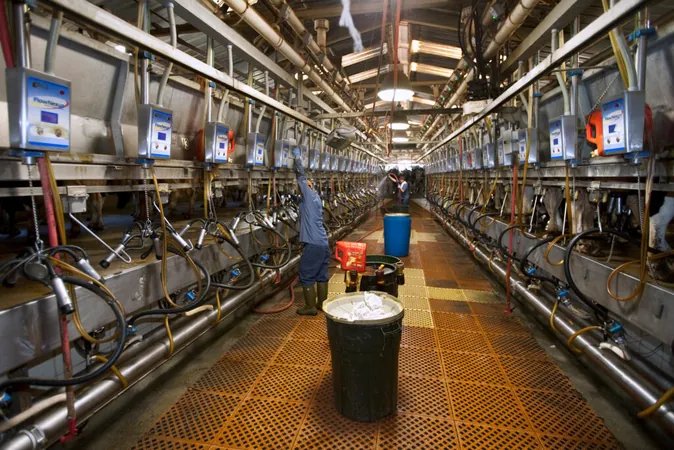
Avian Flu Outbreak Raises Alarming Red Flags Over Agricultural Consolidation
2024-12-09
Author: Wei Ling
As stunning views of California's San Jacinto mountains frame the serene dairy farms nestled in the valley, a silent tension is brewing amongst local farmers. While the cows of Pastime Lakes—a dairy farm housing 1,500 heads—remain untouched by the looming threat of avian flu, concerns run high about the outbreak affecting other livestock.
The H5N1 virus, widely recognized as bird flu, has emerged as a significant concern in the heart of California’s dairy industry, particularly in the San Joaquin Valley. The situation has escalated dramatically, with the state reporting 19 new confirmed cases in cows and a staggering 240,000 in chickens within the current week alone. In Oklahoma, another 50,000 cases were confirmed in a chicken breeding facility, prompting worries about a potential agricultural crisis.
The ripple effects of this outbreak don’t stop at livestock—human health is now in jeopardy. A total of 58 people in the U.S. have tested positive for bird flu, most having close connections to poultry or dairy farms where mass culling took place. Alarmingly, the Centers for Disease Control and Prevention (CDC) indicated that four cases had no apparent links to livestock, heightening fears of a human-to-human transmission capability that, alarmingly, has not yet occurred.
Recent research sheds light on the potential for the H5N1 virus to adapt, with a study from The Scripps Research Institute pointing to the ease with which a single mutation could enable the virus to infect human cells. This is particularly concerning given the environmental conditions within industrial farming facilities, wherein large numbers of genetically similar, often stressed animals coexist in confined spaces—creating perfect conditions for viral transmission akin to a petri dish.
Climate change exacerbates the crisis. Increased temperatures and drought conditions are expected to heighten stress levels among livestock, making them more susceptible to infections, including the bird flu virus. As Paula Ribeiro Prist from the EcoHealth Alliance affirms, a rapid increase in cattle production inevitably raises the chances of viral spread.
Since its detection in a turkey facility in Indiana in February 2022, more than 112 million chickens, turkeys, and other birds have been affected nationwide. The first confirmed case in a dairy cow emerged in Texas earlier this year, marking the alarming crossover of the virus from birds to bovines, with California recording nearly 500 confirmed cases among its cattle.
The consolidation trend in agriculture poses additional challenges. As dairy farming becomes dominated by large-scale operations—where herds are often in the thousands—the risk of widespread infection increases. In stark contrast to the 21,000 dairy farms operating in California in 1950, only about 1,100 remain today, producing a staggering 41 billion pounds of milk. The U.S. dairy sector reflects a similar trend, with large herds becoming the norm.
Originally thought to be airborne, transmission of the H5N1 virus has also been linked to milking equipment and milk itself, suggesting that the industry’s operational practices are compounding the outbreak risks.
The Centers for Biological Diversity underline the dire consequences of raising animals in unsanitary and restrictive conditions, which allows pathogens to flourish unchecked. The intricacies of human-wildlife interaction further complicate the issue, as a changing climate influences bird migration patterns and increases the likelihood of zoonotic diseases spilling over into livestock and eventually humans.
Recent reports from the USDA reveal new threats, including the first case of bird flu detected in a pig on an Oregon farm—a significant find that raises alarms over the potential for cross-species viral adaptations suited for human transmission. This intertwines with the ongoing trend of consolidating multiple species on large-scale farms, which can create an ideal environment for new and dangerous pathogens to emerge.
Despite the seriousness of avian flu, a hidden distress signals lie with farmworkers. Advocates for these workers express concerns that many cases may be underreported, especially among immigrant groups who may avoid medical attention due to fear of repercussions. In Colorado, outreach efforts have uncovered numerous instances of flu-like symptoms among dairy workers, yet lack of access to healthcare remains a barrier.
As the specter of avian flu looms over the agricultural landscape, the intersection of food production practices, environmental changes, and human welfare becomes increasingly disturbing. What are the implications for the future of farming? And could this outbreak be a wake-up call for a critical reassessment of our agricultural systems? As the situation evolves, the stakes couldn't be higher.


 Brasil (PT)
Brasil (PT)
 Canada (EN)
Canada (EN)
 Chile (ES)
Chile (ES)
 España (ES)
España (ES)
 France (FR)
France (FR)
 Hong Kong (EN)
Hong Kong (EN)
 Italia (IT)
Italia (IT)
 日本 (JA)
日本 (JA)
 Magyarország (HU)
Magyarország (HU)
 Norge (NO)
Norge (NO)
 Polska (PL)
Polska (PL)
 Schweiz (DE)
Schweiz (DE)
 Singapore (EN)
Singapore (EN)
 Sverige (SV)
Sverige (SV)
 Suomi (FI)
Suomi (FI)
 Türkiye (TR)
Türkiye (TR)